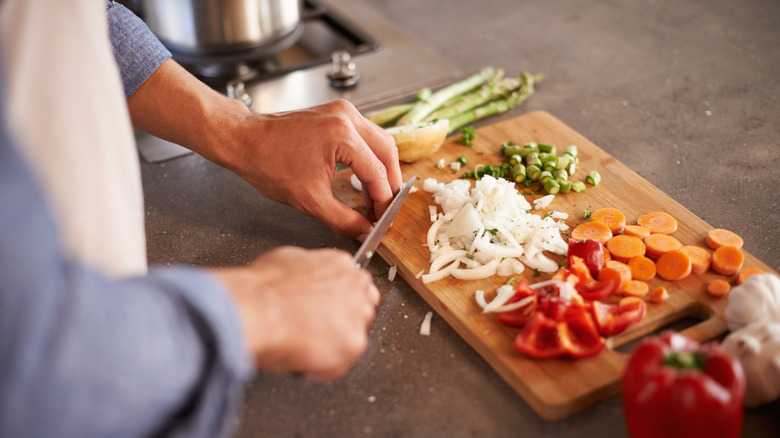How to Make Your Cutting Board White Again: Secrets and Tips for BBQ Enthusiasts
Written By James Morgan
As a barbecue enthusiast, you know the importance of maintaining your kitchen tools. One tool that often gets overlooked is your beloved cutting board. Whether it's from chopping meat, vegetables, or herbs, a cutting board can quickly lose its pristine color and become stained. If you've ever wondered how to make your cutting board white again, you're in the right place.

Why Cutting Boards Get Stained
Cutting boards are workhorses in the kitchen. They see a lot of action, from slicing juicy tomatoes to dicing aromatic onions. Over time, these activities can leave your cutting board looking dull and stained.
Common Causes of Stains
- Food Elements: Fruits, vegetables, and spices, especially those with strong colors like beets, carrots, and turmeric, can easily stain your cutting board.
- Proteins: Raw meat, fish, and poultry can leave behind bloody stains that are tough to remove.
- Acids: Ingredients like vinegar and lemon juice can cause discoloration and dullness.
This article will guide you through various techniques on how to make cutting board white again. You'll find practical tips and strategies that you can implement right away.

Preparation: What You Need
Before diving into the cleaning methods, gather these essential items:
- Baking Soda
- White Vinegar
- Hydrogen Peroxide
- Bleach (Optional)
- Lemon Juice
- Salt
- Soap
- Water
- Scrubbing Brush

Step-by-Step Cleaning Methods
Using Baking Soda and Vinegar
- First, sprinkle a generous amount of baking soda over the surface of the cutting board.
- Saturate the baking soda with white vinegar. You'll see bubbles forming; this reaction helps lift stains.
- Let it sit for about 10 minutes, then scrub the board with a brush.
- Rinse thoroughly with water and let it air dry.
Hydrogen Peroxide Solution
- Mix hydrogen peroxide with water in equal parts.
- Apply the solution to your cutting board.
- Let it sit for 5-10 minutes.
- Scrub the board and rinse it well.
Lemon and Salt Scrub
- Sprinkle salt over the cutting board.
- Cut a lemon in half and use it to scrub the salt into the board.
- Let it sit for a few minutes, then rinse with warm water.

Advanced Techniques
If the above methods don't fully restore your cutting board's whiteness, consider the following advanced techniques:
Bleach Solution (Use Cautiously)
- Mix a mild bleach solution (1 tablespoon of bleach to 1 gallon of water).
- Apply it to the cutting board and let it sit for a couple of minutes.
- Rinse thoroughly to remove all traces of bleach.
Note: Bleach can be harsh on wood, so use it sparingly and only when necessary.
Sanding the Surface
For a wooden cutting board, sanding can remove the top layer of wood, effectively erasing deep-set stains:
- Use fine-grit sandpaper to sand the board gently.
- Wipe off the sawdust and then wash the board with soapy water.
Maintenance Tips
To keep your cutting board looking fresh:
- Always clean it immediately after use.
- Apply a food-safe oil regularly to maintain its finish.
- Avoid submerging it in water for a long period to prevent warping.
For more tips, check out prevent cross-contamination when using cutting boards.
Pro Tips from BBQ Lovers
We're not just any cooking enthusiasts; we are BBQ aficionados! Here are some insider tips:
- Marinade Management: Keep separate cutting boards for meats and vegetables to avoid cross-contamination.
- Smoke Residue: After a cozy BBQ session, make sure to clean any soot or smoke residue off your wooden cutting boards to keep them in top shape.
- Storage Hack: Stand your cutting boards on their sides so air can circulate and keep them dry.
Curious about other tricks? Check out our article on cleaning walnut cutting boards.
FAQ
How often should I clean my cutting board?
Ideally, you should clean your cutting board after every use to prevent stains and bacteria buildup.
Is it safe to use bleach on a cutting board?
While bleach can be effective, it should be used sparingly and rinsed thoroughly to ensure no residue is left.
Can I use the dishwasher to clean my cutting board?
It's not recommended for wooden cutting boards, as the high heat and prolonged water exposure can warp and damage the wood. Plastic boards, however, can be dishwasher safe.
For a more in-depth look at cutting board care, visit this detailed guide.
As an Amazon Associate, I earn from qualifying purchases.



